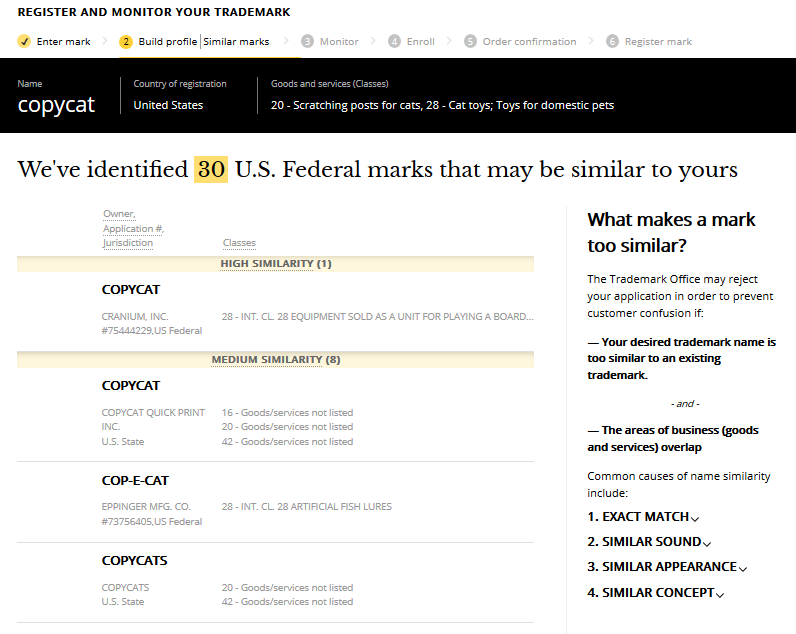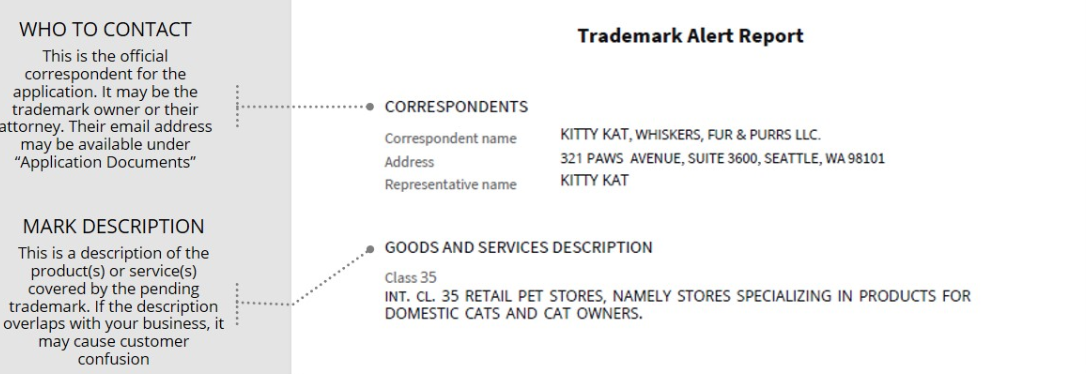Trademark.com, which sponsored this article, is a web-based service that helps small business owners easily and affordably protect their brand identity. Whether you’re ready to trademark your brand with the United States Patent and Trademark Office (USPTO) or already have a mark on-file, Trademark.com can simplify the trademark registration and monitoring process. The service helps you complete a trademark registration application starting at $474, and provides 24/7 monitoring to identify unauthorized copycats for $199/year/mark. Click here to learn more.
What Is Trademark Infringement?
Trademark infringement refers to copycat activity—specifically, the unauthorized use of a company’s trademarked brand that will likely cause confusion regarding the source of products or services. Unfortunately, trademark infringement is extremely common, so it’s critical for business owners to maintain the integrity of their trademark by registering it with the United States Patent and Trademark Office and monitoring it for copycat activity.
Trademark infringement can occur when several factors come into play:
- There is a valid trademark that an individual or business has registered and used as part of their day-to-day business that is now being used by an unauthorized third party.
- The third party is using the mark “in commerce,” meaning in the sales, offers, distribution, or advertising of a product.
- The third party’s use of the trademark likely confuses consumers by associating the wrong brand with a product.
For example, if you trademark a name, logo, and slogan for your food delivery service and another company creates a similar name, logo, or slogan for their document delivery service, they may be infringing on your trademark. Since both businesses are involved in the delivery business, it’s reasonable that customers might confuse the two. However, the infringing company may not even realize they are violating your trademark, so it’s up to you to protect your brand and monitor new trademark applications.

Sign up for trademark protection easily on Trademark.com
Source: Trademark.com
How Trademark.com Protects Against Trademark Infringement
Trademark.com offers a three-part strategy for protecting your brand, which starts with building your trademark profile. If you haven’t already registered your mark, Trademark.com has an easy-to-use tool that helps you quickly determine what industries your trademark would cover using keywords that are preapproved by the U.S. Trademark and Patent Office (USPTO). It’s important to remember that two identical trademarks can coexist as long as they are for unrelated areas of business, so business owners need to be very clear about the kinds of products and services their trademark covers when preparing their application.
As part of establishing your trademark profile, Trademark.com also offers a complimentary search of already registered trademarks to help you make sure that your desired mark doesn’t conflict. Results ranked by similarity make it easy to understand and will help you determine whether your name is sufficiently unique, or whether you should consider making a change.
The second factor of the protection strategy involves trademark monitoring. Trademark.com looks for conflicts that could harm your business by monitoring trademark applications filed with the USPTO, even while your own trademark registration application is processed. A weekly Trademark Alert Report delivered right to your email inbox keeps you up-to-date on potential copycat activity and provides useful information for taking action quickly.
Trademark registration with the USPTO rounds out the protection strategy. Along with their industry partner, Marcaria, Trademark.com helps small business owners prepare an application to legally secure their rights nationwide. In addition to proof of ownership, registering your trademark with the Trademark Office gives you certain advantages in court if there’s an infringement dispute regarding your brand.
A Closer Look: Trademark Filing
Nuanced and complex, the trademarking filing process is regulated by the USPTO and takes several months. Trademark.com helps you register your trademark by teaming up with their industry partner, Marcaria. When you submit trademark information with Trademark.com, they share it with Marcaria staff, who help with processing and legal questions.
After your information is submitted to Marcaria through Trademark.com, attorneys will make sure your application is complete and contact you with any questions. A thorough application review is very important because the USPTO does not refund fees if the mark is rejected. Marcaria and your attorney will keep you updated about the status of your application as it moves through the approval process.
A Closer Look: Trademark Monitoring
Once a business owns the rights to a trademark (whether at the local level through use or at the national level by way of registration), it’s responsible for enforcing them. The USPTO attempts to ensure that no other party receives a federal registration for an identical or similar mark in the same industry, but they do not “police” marks. This means that trademark owners must keep a constant eye on all new trademark applications to make sure no one else successfully registers an identical or suspiciously similar name. And there’s no room for slacking because time is of the essence; in the U.S., registered trademark owners only have 30 days to oppose copycats.
Trademark.com helps you enforce your rights and take action when you suspect your trademark is at risk by providing 24/7 systematic monitoring of incoming trademark applications. Trademark.com’s monitoring clients receive a weekly Trademark Alert Report for each of their brands or trademarks. These reports include any newly filed or pending trademark applications that are the same or suspiciously similar to their pending or registered trademark.
Alert reports include additional information about how to protect trademarks from copycats. It’s also affordable compared to traditional intellectual property (IP) law firms or other options; tracking with the help of an IP lawyer can be prohibitively expensive for small business owners.

Screenshot of Trademark.com Trademark Alert Report
Source: Trademark.com
Trademark.com Costs
Trademark.com helps you register your trademark by teaming up with their industry partner, Marcaria. Trademark registration starts at $474 for a word-based trademark application with one class, sometimes known as a trademark category (federal fees and taxes included). Trademark monitoring costs $199 plus tax for a full year of service. This includes weekly alert reports that keep you updated on the status of your trademark, as well as best practice tips for protecting your trademark.
Who Trademark.com Is Right For
Trademark.com helps small business owners looking for help registering a trademark, wanting to protect an existing mark from infringement, or both. If you need help filing your trademark or have a pending trademark, Trademark.com can screen for similar trademarks in the USPTO database. Once you have registered with the USPTO, Trademark.com continuously monitors new trademark applications filed with the USPTO for problematically similar marks.
When to Use Trademark.com
You can sign up for Trademark.com at any time, but there are two ideal times to start using the platform: before you register your trademark and right after your trademark is secured. The earlier you start using the service, the less likely you are to lose your ability to defend your trademark against infringement.
In general, you can start using Trademark.com at several times, including:
- Before you register your trademark: Trademark.com’s partner, Marcaria, will connect you with a lawyer and provide the assistance needed to trademark your business name. Marcaria and your attorney will handle the preparation and submission of your trademark application to the USPTO. Once filed, Trademark.com will monitor to ensure new applications don’t infringe on your pending trademark.
- During the trademark application process: Trademark.com can alert you to copycat applications that arise during the processing of your application.
- Any time after your trademark is registered: Once you have a formally registered trademark, Trademark.com will monitor their robust database and notify you if someone else tries to register a mark that is identical or suspiciously similar to your own.
How to Trademark a Business Name With Trademark.com in 4 Steps
To make the most of Trademark.com’s services, ensure your brand is not in use elsewhere; let their partner, Marcaria, help with filing your trademark application; and take full advantage of your Trademark.com Trademark Alert Report. Then, use Trademark.com resources to confidently take action on infringements against your mark.
Here are the four steps for using Trademark.com to register and protect your trademark:
1. Sign Up With Trademark.com Early
When it comes to trademarks, timing is everything. On average, the trademark application process can take between six months and one year, so it’s important to file your trademark application as soon as possible. If you already have a trademark, note that trademark owners only have 30 days to oppose a problematically similar trademark application with the USPTO. For that reason, early registration and monitoring are extremely important.
Trademark.com can coordinate the services necessary to submit your trademark application through their partner, Marcaria, and the attorneys that Marcaria work with. Simply navigate to Trademark.com’s homepage and click on “Register.” The platform also monitors applications to watch out for copycats that appear before registration is complete. If you have an existing trademark and need 24/7 monitoring, click “Monitor” on the Trademark.com homepage.
To ensure effective tracking, Trademark.com’s database is error-corrected to avoid misspellings, misclassifications, and coding errors, and expert analysts verify incoming USPTO data for quality and accuracy. Plus, 24/7 monitoring and detailed alert reports mean you’re always aware of your trademark status.

Registering your trademark with Trademark.com
Source: Trademark.com
2. Ensure Your Trademark Is Unique
Whether Trademark.com is helping you file and claim your trademark or you’re filing your own application with the USPTO, first determine whether your trademark is already in use. Review existing trademark data, conduct a common law search, and check social media and the internet to evaluate whether your trademark is already in use. Once you confirm availability within the U.S., confirm international availability using the relevant foreign trademark offices.
Check Existing Trademark Data
Start your trademark search using the USPTO’s Trademark Electronic Search System (TESS) and Trademark Status and Document Retrieval (TSDR) database. When searching for your brand, however, note that TESS and TSDR aren’t very user-friendly, and data can be incomplete due to user error during the application process. For the most accurate, comprehensive, and easy-to-use trademark data, use Trademark.com’s free search tool to check your brand.

Use Trademark.com’s easy search tool to find available trademarks
Source: Trademark.com
Conduct a Common Law Search
Not all brands are properly registered with the USPTO, so it’s important to review unregistered product and company names before attempting to claim a trademark. This is especially important because some places, including the U.S., let brand owners acquire trademark rights without formally registering their trademark; a so-called common law trademark can be obtained simply by using a brand in a business’ day-to-day operations.
To evaluate whether you may face enforcement actions from common law trademark holders, conduct a thorough search of the internet, business directories, and any publications relevant to your field. Even though common law trademarks won’t always show up in formal searches of USPTO data, they can still lead to enforcement issues if you aren’t aware of them early on.
Establish a Social Media & Online Presence
Even if you’re not trademarking your brand, always confirm the availability of your brand name on popular social media platforms. Searching Facebook, Instagram, Twitter, and other platforms can help you determine whether there are any common law trademarks; plus, conducting this search early in the application process lets you claim the necessary social media handles before someone else does. Also, make sure your desired web domain is available before registering.
Confirm International Availability
Once you confirm your brand isn’t already trademarked or in use in the U.S., consider other countries where you’ll conduct business. If you plan to open an office in a foreign market, check with the local trademark office to understand the trademark application process and confirm your trademark isn’t already in use. Also, look into whether your business name, logo, and other branding elements might be offensive or otherwise inappropriate in other languages.
3. Take Advantage of Your Trademark Alert Report
After your trademark application is filed, review Trademark.com’s Trademark Alert Report, which shows the details of your trademark and lists other trademarks that are similar to your brand. The entry for each potential threat includes information about where the trademark is being registered, contact information for the applicants, the categories of products and services covered by the pending trademark, and more.
The Trademark Alert Report also includes options and guidance on how to follow up regarding potential threats. Most importantly, the report includes the opposition date. According to the USPTO, the opposition date is the cutoff date by which you must file an opposition notice (complaint) with the USPTO to challenge the trademark. Trademark.com provides contact information for the official correspondent assigned to the copycat application so you can follow up directly.

Screenshot of portion of Trademark Alert Report
Source: Trademark.com
4. Oppose Copycats With Confidence
Once you discover a potential threat to your pending trademark or registered trademark, Trademark.com offers resources to help you protect your brand. Trademark.com’s Trademark Alert Report is a helpful tool for preparing enforcement actions.
“While you should consult an attorney to determine the right course of action for your particular scenario, there are several possible options when you encounter a trademark copycat. Enforcing trademark rights starts with proactively monitoring your mark so you’re aware of any potential conflict before it even reaches the marketplace. It’s critical to set time aside to review your Trademark Alerts Report on a regular weekly basis so you can take action in time. If you catch the issue very early, one option is to send a cease and desist letter, or a demand letter.
“Alternatively, if the problematically similar mark is in the application stage, you can consider filing an opposition notice with the USPTO. Before a mark is successfully registered in the U.S., there is an ‘opposition period’ during which trademark owners who believe their rights would be harmed by registration of the new mark have 30 days to challenge the application. Generally much less expensive than federal litigation, oppositions can often result in the other party giving up on the mark. In other situations, it can be an opportunity for both business owners to negotiate changes to the application that allow the marks to coexist without causing confusion in the market.”
– Jeff Roy, General Manager, Trademark.com
Frequently Asked Questions (FAQs)
What is the difference between Trademark vs Registered?
Trademark rules for marking logos, slogans, and other branding materials depend on where a trademark is in the application process. A trademark (™) means that the user has common-law rights in a trademark. Unregistered brand names and pending trademark applications should be marked with “™.” In contrast, a registered trademark (®) means that the trademark has already been registered and is recognized by the USPTO.
How do I trademark my brand?
Trademark your brand using Trademark.com or directly through the United States Patent and Trademark Office (USPTO). To apply through the USPTO, complete the initial application forms online, pay the requisite filing fees, and respond to the USPTO’s subsequent inquiries and requests. To simplify the process and get help monitoring your pending trademark, try Trademark.com’s registration services.
How do you find out if a name is trademarked?
Use Trademark.com’s trademark search tool to discover whether something similar is already in use. Not only is the tool free, but it also includes comprehensive and error-corrected data from the USPTO so you don’t have to worry about owner entry error. To access the free tool, create a free account on Trademark.com, select “Register,” and fill in a few questions about your desired trademark.
Can you trademark a company name?
You can trademark a company name through Trademark.com or the USPTO. Your trademark format doesn’t change the type of application required, but you must provide an additional statement if your trademark includes the name of a living person. Choose Trademark.com to save time and frustration and to simplify the nuanced application process.
How do I register a slogan?
Register a slogan with the help of Trademark.com or through the USPTO. Like other trademarks, registering a slogan through the USPTO requires filing an initial application form and responding to questions from the agency. Opt for Trademark.com’s filing service to simplify the process and reduce back-and-forth with regulators.
How long does the USPTO take to approve a trademark?
Trademark processing times depend on the trademark’s complexity and whether or not the USPTO encounters legal issues during their review. After submitting your application materials, you’ll likely hear from the USPTO within three months. However, it can take six months to over a year to fully process the application. You can check the current estimated processing time on the USPTO’s Trademarks Dashboard.
Bottom Line
Trademark.com, which sponsored this article, can show you how to copyright a business name and other branding content without navigating the frustrating USPTO filing process. Use the platform to help register your trademark starting at $474 and get 24/7 monitoring for $199 per trademark, per year. Then, stay ahead of copycats and protect your brand using the Trademark Alert Reports.
Whether you’re ready to trademark your brand or already have a trademark on file, Trademark.com can simplify the trademark registration and monitoring process. Click here to learn more.
Read More


0 تعليقات